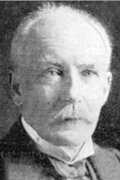 |
Sydney Charles Buxton
b. 25 Oct 1853, London, England, U.K.
d. 15 Oct 1934, Newtimber Place, Sussex, U.K. |
| Title: |
Governor-General and Commander-in-Chief in and over the Union of South Africa ::
Goeverneur-generaal en Opperbevelhebber in en over de Unie van Zuid-Afrika |
| Term: |
8 Sep 1914 - 20 Nov 1920 |
| Chronology: |
14 May 1914,
appointed by Commission under the Royal Sign Manual and Signet [1] |
| |
8 Sep 1914, took an oath of allegiance and an oath of office as Governor-General and Commander-in-Chief of the Union of South Africa, Cape Town [2] |
| |
20 Nov 1920,
appointment superseded by the Commission of a successor effective on taking the prescribed oaths (20 Nov 1920) [3][4] |
| Names/titles: |
Nobility titles (conferred): Viscount Buxton, of Newtimber, in the county of Sussex (from 11 May 1914); Earl Buxton (from 8 Nov 1920) [5] |
| Biography: |
| Second son of Charles Buxton, Liberal Member of Parliament; born into a notable Quaker family which made its fortune from the brewery business in East London's Spitalfields; was educated at Clifton College; enrolled in Trinity College, Cambridge (1872), but ill-health compelled him to leave before taking a degree; entered politics by winning the election to the London School Board (served 1876-1882); stood unsuccessfully in the 1880 General Election; became prominent in political circles after publishing A Handbook to Political Questions of the Day (1880) and other books; was elected to Parliament in a by-election and represented Peterborough (1883-1885); lost his Peterborough seat in 1885 but was elected in the 1886 General Election for the East London seat of Poplar (1886-1914); served on the Royal Commission on Elementary Education (1886-1888); was appointed Under-Secretary of State for the Colonies (1892-1895) in the last government of William Ewart Gladstone; became one of the Liberal Party's experts on labour matters; sworn in as a member of the UK Privy Council (11 Dec 1905); entered the cabinet of Sir Henry Campbell-Bannerman as Postmaster General (11 Dec 1905 - 19 Feb 1910); succeeded Winston Spencer-Churchill as President of the Board of Trade (19 Feb 1910 - 12 Feb 1914); was responsible for conciliation during the labour unrest of 1910-1914; served as Governor-General of the Union of South Africa and High Commissioner for South Africa (8 Sep 1914 - 20 Nov 1920); upon his return, he chaired a committee on the constitutional development of Southern Rhodesia (1921); declined to be considered as a successor to Edward Grey, Viscount Grey of Fallodon, as Liberal leader in the House of Lords (1924); during the Liberal rifts over the General Strike (1926), he sided with Herbert Henry Asquith and Grey against David Lloyd George. |
| Biographical sources: "A Liberal Life: Sydney, Earl Buxton, 1853-1934: Statesman, Governor-General of South Africa", by Daniel Wiley (Sussex, UK: Newtimber Publications, 1999); The Times, No. 46,886, Royal Edition, 16 Oct 1934, pp. 1, 9, 14 (obituary). |
| |
| [1] |
Government Gazette, No. 571, Extra, 8 Sep 1914, p. ii. |
| [2] |
Government Gazette, No. 571, Extra, 8 Sep 1914, pp. (i)-ii. |
| [3] |
Government Gazette, No. 1106, Extra, 23 Nov 1920, p. (425). |
| [4] |
After Earl Buxton permanently left South Africa, his functions were taken over by Sir James Rose-Innes as Officer Administering the Government of the Union of South Africa :: Ambtenaar belast met de Regering van de Unie van Zuid-Afrika (3 Sep 1920 - 20 Nov 1920) who continued in office until the installation of Prince Arthur of Connaught. |
| [5] |
London Gazette, No. 28830, 12 May 1914, p. 3835; London Gazette, No. 32122, 12 Nov 1920, pp. 10979-1080. |

